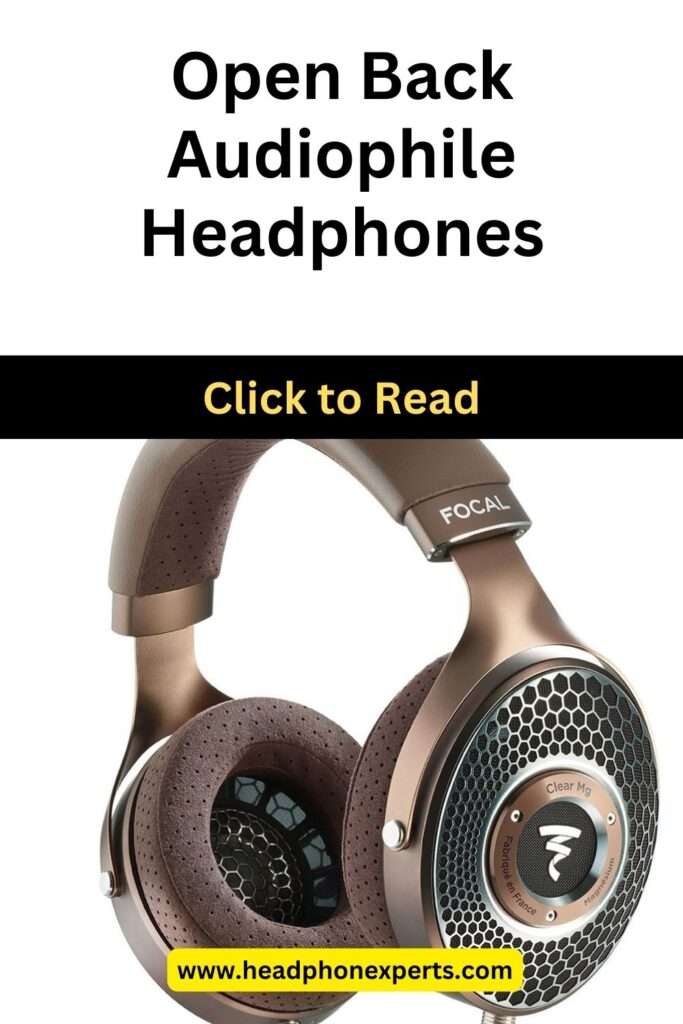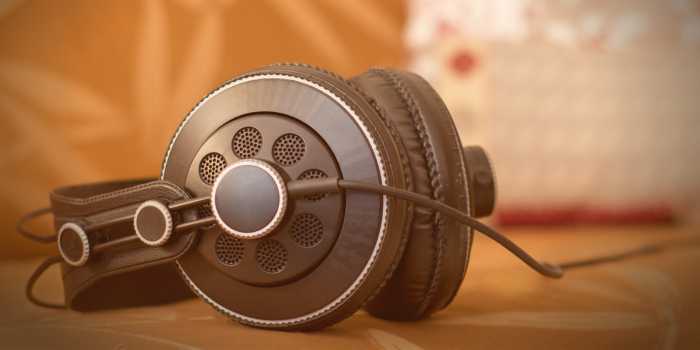The ever-evolving world of audio enthusiasts has given rise to a growing number of people who share a common interest in the quest for sonic perfection. People who have a profound appreciation for high-fidelity sound are known as audiophiles, and they are always looking for ways to improve the quality of their listening experiences.
Within the realm of headphones, there is one category that stands out as a symbol of uncompromising audio quality, and that category is open-back audiophile headphones. Choosing the right headphones for this quest is one of the most important aspects of the mission.
Because of their one-of-a-kind appearance and exceptional sound characteristics, open-back audiophile headphones have seen a rise in popularity among music enthusiasts with discerning tastes and professionals in the audio industry.
In this article, we will delve into the distinguishing characteristics of open-back audiophile headphones, as well as the benefits they offer and the effect they have on the listening experience of audiophiles. We will also discuss the impact these headphones have on the overall audiophile experience.
As we move forward with this investigation, we are going to delve into the complexities of open-back headphones in order to find out what distinguishes them from their counterparts with closed-backs.
We are going to delve deeply into the never-ending quest for audio perfection that audiophiles have, as well as the important role that open-back headphones play in reaching that goal.
We will equip you with the knowledge you need to make an educated decision when selecting your own pair of open-back audiophile headphones by dissecting sound quality, as well as providing practical considerations and maintenance tips.
Join us as we explore the world of open-back audiophile headphones, a world in which every note, every detail, and every nuance matters. Whether you’re an experienced audiophile looking to improve your setup or a curious newcomer seeking to understand the nuances of high-fidelity audio, we invite you to come along on this journey with us.
The Ultimate Guide to Choosing the Right Audio Headphones
In This Topic We will cover:-
- Recognizing Open-Back Headphones
- The Audiophile Encounter
- Quality of Sound and Open-Back Headphones
- Real-World Considerations
- Open-Back Audiophile Headphones
- How to Select the Best Open-Back Audiophile Headphones
- Keeping Your Open-Back Audiophile Headphones in Good Condition
2. Recognizing Open-Back Headphones
Before delving deeper into the world of open-back audiophile headphones, it’s critical to grasp the fundamental concepts that distinguish them.
When compared to closed-back headphones, open-back headphones have a distinct design and operation. In this section, we’ll look at what open-back headphones are, how they’re made, and how they differ from closed-back headphones.
A. Definition and Fundamental Design Principles
Open-back headphones are defined as follows: Open-back headphones are a type of over-ear headphone with open ear cups that allow air and sound to freely flow in and out.
Grille style: On the back of each ear cup, open-back headphones typically have a grille or perforated surface. This grille allows sound waves to escape from the headphone drivers’ rear.
Sound leaking: Open-back headphones, unlike closed-back headphones, do not have sealed ear cups, allowing sound to pass in and out of the headphones. This design decision is critical to their distinct sound characteristics.
B. Evaluation of Closed-Back Headphones
Closed vs. open design: Closed-back headphones have sealed ear cups that isolate the listener from outside noise and minimize sound leakage. Open-back headphones, on the other hand, have open ear cups that let some ambient noise in while blocking out sound.
Imaging and soundstage: Closed-back headphones typically produce a narrower soundstage, whereas open-back headphones excel at producing a more spacious, natural soundstage with precise imaging.
Due to their sealed design, closed-back headphones have a stronger bass response, whereas open-back headphones may sacrifice some bass for improved soundstage and clarity.
C. Benefits and Drawbacks of Open-Back Headphones
Advantages:
Sound quality: Open-back headphones are favored by audiophiles and professionals for their ability to deliver a more natural, spacious, and detailed soundstage.
Because of better ventilation, the open design often results in a cooler listening experience during extended sessions.
Reduced ear fatigue: Because open-back headphones allow airflow, they cause less ear fatigue during long listening sessions.
Disadvantages:
Open-back headphones have limited noise isolation because they let in external sounds and leak sound into the environment.
Not portable: Because of their bulkier design and susceptibility to external noise, they are less suitable for on-the-go use.
While open-back headphones provide excellent soundstage and detail, they may have less pronounced bass than closed-back models.
Understanding these fundamental aspects of open-back headphones prepares us for a more in-depth examination of their impact on sound quality and the audiophile experience, which we’ll do in the sections that follow.
3. The Audiophile Encounter
Audiophiles are a distinct subset of music enthusiasts who demand the highest sound quality possible. Their pursuit of audio perfection is motivated by their love of music and desire to experience it in its purest form.
This section explores what it means to be an audiophile, the role headphones play in the audiophile experience, and how open-back headphones fit into the pursuit of sonic excellence.
A. What characteristics define an audiophile?
The definition of an audiophile is a person with a fervent and discriminating interest in high-fidelity audio reproduction.
Audiophiles devote time, energy, and resources to achieving the highest possible sound quality in their audio systems, whether for music, films, or other forms of entertainment.
Aiming for a listening experience as close as possible to the original recording, audiophiles strive to capture every nuance, detail, and emotion in the music they cherish.
B. The Contribution of Headphones to the Audiophile’s Quest for Audio Perfection
Personal listening environment: Audiophiles frequently designate listening spaces in order to eliminate external disturbances and optimize the acoustic environment.
Critical listening: Audiophiles engage in critical listening sessions, during which they concentrate intently on the music and dissect it in order to appreciate every nuance.
The advantage of headphones is that they provide an intimate listening experience and a level of detail that rivals that of traditional speaker systems. Additionally, they enable audiophiles to listen in private without disturbing others.
C. How Open-Back Headphones Contribute to Audiophile-Grade Sound
Open-back headphones are renowned for their ability to produce a wide, immersive soundstage. This characteristic is valued by audiophiles for its ability to faithfully reproduce the spatial qualities of recorded music.
Clarity and detail: Open-back headphones are prized by audiophiles for their ability to reveal intricate musical details and nuances, from delicate vocals to subtle instrumentation.
Open-back headphones typically provide a more natural and lifelike listening experience, as if the music is taking place in a real acoustic space.
Open-back headphones are an indispensable tool for audiophiles in their pursuit of the ultimate listening experience. Their distinctive design and sonic characteristics align with the audiophile’s pursuit of audio perfection, making them the preferred option for those who seek the highest level of sound quality.
In the following sections, we’ll explore in greater detail how open-back headphones contribute to superior sound quality, including their impact on soundstage, clarity, and other sonic aspects that matter to audiophiles.
4. Quality of Sound and Open-Back Headphones
Open-back headphones are the best option for audiophiles and discriminating listeners when it comes to audio quality.
In this section, we will delve into the specifics of sound quality, explaining how open-back headphones excel in a variety of areas and why they are revered for their ability to provide an immersive and captivating listening experience.
A. Explanation of Sound Quality Factors in Extensive Detail
Open-back headphones are highly regarded for their exceptional soundstage. This refers to the perceived spatial dimensions of sound, which allows listeners to feel immersed in the music.
The soundstage of open-back headphones is typically larger and more expansive than that of closed-back headphones, resulting in a more immersive and natural listening experience.
Imaging is the capability of headphones to precisely position individual sound sources within the soundstage. Open-back headphones excel in this regard, providing precise and realistic instrument and vocal placement.
This attribute enables listeners to pinpoint the location of each instrument, thereby enhancing the audio’s overall immersion and realism.
Open-back headphones are highly regarded for their clarity. The open design minimizes internal resonances and reflections, resulting in audio that is clearer and more detailed.
From subtle reverb tails to the delicate decay of a note, every nuance of the music is faithfully reproduced, allowing listeners to appreciate the full range of sonic detail.
B. The Effects of Open-Back Design on Soundstage and Imaging
Soundstage Enhancement: The open-back design of headphones prevents sound from bouncing back into the listener’s ears by allowing sound waves to pass through the rear of the ear cups.
This prevents the “in-your-head” sound typically associated with closed-back headphones and contributes to the expansive soundstage of open-back models.
Open-back headphones provide precise imaging by allowing sound to disperse naturally, thereby producing a more accurate representation of the spatial characteristics of the recording. Instruments and vocals are perceived as separate entities on the soundstage, thereby enhancing the overall listening experience.
C. Clarity, Specificity, and Realism: The Strengths of Open-Back Headphones.
The absence of sound reflections and resonances within the ear cups of open-back headphones results in a sound that is clearer and more transparent. This clarity enables listeners to distinguish minute musical details, such as the delicate brushing of drumsticks against a cymbal or the faint breathiness in a singer’s voice.
Open-back headphones excel at reproducing fine sonic details that other headphones might obscure. Audiophiles delight in the ability to unearth hidden elements in their favorite songs, which gives them a new appreciation for the music.
Open-back headphones typically offer a more natural and authentic listening experience. The absence of artificial sound reflections creates a sense of openness and transparency, as if the music were taking place in a real acoustic space. This realism enhances the listener’s emotional connection to the music.
In conclusion, open-back headphones provide an exceptional listening experience due to their superior soundstage, imaging, clarity, and realism.
These qualities make them a favorite among audiophiles and those who value an immersive and genuine musical experience. In the following section, we will discuss practical considerations for using open-back audiophile headphones and how they perform in a variety of situations.
5. Real-World Considerations
Although open-back audiophile headphones provide a superior listening experience in terms of sound quality, potential users should be aware of certain practical considerations.
In this section, we’ll examine when it makes sense to use open-back headphones, discuss noise isolation and sound leakage concerns, and outline recommended usage scenarios for these specialized audio devices.
A. When and Where Open-Back Headphones Should Be Used
Open-back headphones thrive in quiet, controlled listening environments. They are ideal for dedicated listening spaces where external noise can be reduced.
Open-back headphones are frequently used by audiophiles as part of their home audio systems. For a premium listening experience, they pair well with high-quality headphone amplifiers and digital-to-analog converters (DACs).
Critical Listening: Open-back headphones are ideal for critical listening sessions where the focus is on appreciating music in its purest form.
Studio and Mixing: Audio professionals, including musicians and recording engineers, often use open-back headphones for studio monitoring and mixing tasks due to their accuracy and clarity.
B. Concerns Regarding Noise Isolation and Leakage
Open-back headphones do not provide a significant amount of noise isolation. They permit external sounds to enter and can be disrupted by ambient noise, making them unsuitable for use in noisy environments such as commutes or crowded coffee shops.
Open-back headphones leak sound into the surrounding area, allowing others to hear what you are listening to. This can be problematic in quiet environments or when sharing a workspace.
C. Recommendations for Open-Back Audiophile Headphone Usage
At-Home Dedicated Listening Sessions Open-back headphones are ideal for devoted listening sessions. Relax in your favorite chair, dim the lights, and immerse yourself in your preferred music or films.
Studio Work: If you’re an audio professional, open-back headphones can be a valuable tool for mixing and critical listening tasks in a controlled studio environment.
Office or Study Area: Open-back headphones can provide an exceptional listening experience without disturbing others in a quiet office or study with minimal background noise.
Although open-back headphones have exceptional sound quality, they may not be appropriate for all situations. Before selecting open-back headphones, users should consider their listening environment and individual needs.
In situations where noise isolation and privacy are of the utmost importance, closed-back headphones or noise-canceling headphones may be preferable.
In the following section, we will examine popular models of open-back audiophile headphones, highlighting their key features and assisting you in making an informed decision when selecting a pair that meets your preferences and requirements.
6. Open-Back Audiophile Headphones
When it comes to audiophile headphones with open backs, there is a wide variety of choice available at a variety of price points.
In the following paragraphs, we’ll familiarize you with a few of the most well-known models that have received praise from audiophiles and other music enthusiasts.
In order to assist you in making an educated choice, we will summarize some of their most important qualities, including their distinctive selling points, as well as their advantages and disadvantages.
A. Sennheiser HD 800 S
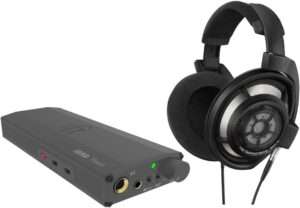
In the ever-evolving landscape of audio technology, certain names stand as legendary pillars of innovation and excellence. Sennheiser is a globally recognized brand among audiophiles and music enthusiasts.
The “Sennheiser HD 800 S” holds a prominent position in Sennheiser’s illustrious product catalog. Due to its unwavering commitment to sonic excellence, the HD 800 S has achieved legendary status in the world of high-end headphones.
Few headphones can match the HD 800 S’s combination of precision engineering, advanced materials, and unrelenting pursuit of sonic perfection.
In this investigation, we will explore the extraordinary world of the Sennheiser HD 800 S, including its design, technology, and the captivating listening experience it offers audiophiles. Join us as we disassemble the audio masterpiece referred to as the “Sennheiser HD 800 S.”
Key Features:
- Exceptional soundstage and imaging.
- Natural and transparent sound signature.
- High-quality materials and build.
Pros:
- Outstanding sound quality for critical listening.
- Comfortable for extended listening sessions.
- Premium construction and aesthetics.
Cons:
- High price point.
- Requires a quality headphone amplifier for optimal performance.
B. Beyerdynamic DT 990 Pro
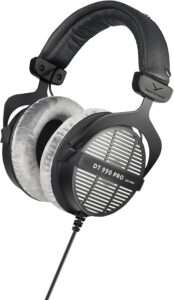
In the realm of high-fidelity audio, where every note, nuance, and sonic detail is significant, there exists a realm of headphones that is exemplary.
Among these revered audio devices, the Beyerdynamic DT 990 Pro headphones stand out as a formidable force, captivating audiophiles and professionals alike.
The DT 990 Pro headphones have carved out a unique niche in the world of audio enthusiasts and studio professionals due to their renowned precision, clarity, and timeless design.
In this exploration, we embark on a sonic journey to discover the remarkable qualities and enduring appeal of the audiophile Beyerdynamic DT 990 Pro headphones.
Join us as we delve into this audio masterpiece’s symphony of sound, craftsmanship, and innovation. The Beyerdynamic DT 990 Pro headphones bring music to life like never before.
Key Features:
- V-shaped sound signature with pronounced bass and treble.
- Comfortable velour ear cushions.
- Affordable price point for audiophile-grade sound.
Pros:
- Crisp and energetic sound.
- Excellent value for the sound quality.
- Available in different impedance options for various setups.
Cons:
- Sound signature may not suit all preferences.
- Some users find the treble to be too bright.
C. Audeze LCD-X
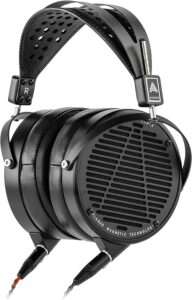
The Audeze LCD-X audiophile headphones are a testament to unwavering quality and innovation in the world of high-end audio, where accuracy and sonic excellence rule supreme.
These headphones have a reputation that goes above and beyond the norm and are revered by both audiophiles and music industry professionals.
The Audeze LCD-X headphones invite us to embark on an extraordinary auditory journey with their meticulous craftsmanship, cutting-edge technology, and unwavering commitment to audio purity.
In this investigation, we’ll delve into the world of the Audeze LCD-X, learning about their intricate design, unique engineering feats, and the unmatched listening experience they provide for those who demand nothing less than the best sound quality. Come along with us as we explore the exquisite world of the Audeze LCD-X audiophile headphones.
Key Features:
- Planar magnetic drivers for exceptional clarity.
- Warm and engaging sound signature.
- Premium wood and metal construction.
Pros:
- Rich, detailed, and spacious sound.
- Luxurious materials and craftsmanship.
- Well-suited for audiophiles and professionals.
Cons:
- Heavier and bulkier than some other models.
- Requires a powerful headphone amplifier.
D. Audio-Technica ATH-R70x
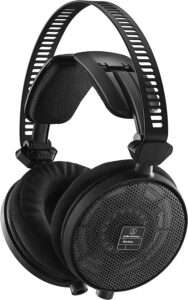
There is a special breed of headphones that are the pinnacle of excellence in the world of high-fidelity audio, where every detail and note is treasured.
Among them is the Audio-Technica ATH-R70x, a set of audiophile headphones that has won over discerning music lovers all over the world.
The ATH-R70x headphones are more than just an audio accessory renowned for their remarkable sonic transparency, precise engineering, and unwavering dedication to delivering an authentic listening experience they are a window into a world of sound where music is felt as deeply as it is heard.
We set out on a sonic journey in this investigation to learn more about the outstanding features and alluring essence of the Audio-Technica ATH-R70x audiophile headphones.
Key Features:
- Lightweight and comfortable design.
- Smooth and balanced sound signature.
- Dual-sided detachable cables.
Pros:
- Accurate and transparent sound.
- Comfortable for long listening sessions.
- Competitive price for the sound quality.
Cons:
- May lack the same level of bass impact as other models.
- Open-back design means limited noise isolation.
E. HIFIMAN HE-400i
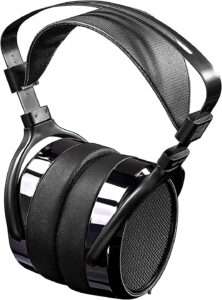
The HIFIMAN HE-400i is one such shining name in the world of high-fidelity audio, where the pursuit of sonic perfection knows no bounds. These audiophile headphones have established a reputation for being fierce competitors in the search for unmatched sound quality and musical immersion.
The HIFIMAN HE-400i headphones entice audiophiles and music lovers into a world where every note, every nuance, and every emotion in a piece of music is unveiled with astounding clarity thanks to their exquisite craftsmanship and cutting-edge technology.
We delve into the fascinating world of the HIFIMAN HE-400i audiophile headphones in this investigation, examining their exceptional features, design ethos, and the musical journey they promise to take wearers on. Join us as we use the HIFIMAN HE-400i to take you on an auditory journey into the heart of high-fidelity audio.
Key Features:
- Planar magnetic drivers for clarity and detail.
- Lightweight and comfortable design.
- Affordable entry into high-quality audio.
Pros:
- Excellent sound quality for the price.
- Comfortable and lightweight.
- Well-suited for audiophile beginners.
Cons:
- Build quality may not be as robust as higher-end models.
- Some users find the headband design less comfortable.
These are just some examples of popular open-back audiophile headphones; on the market, you can find a wide variety of other options to choose from.
When selecting a set, it is important to think about your spending limits, the kinds of sounds you like, and the activities you intend to do with the headphones.
In addition, keep in mind that in order to reach their full potential, open-back headphones frequently require the assistance of a specialized headphone amplifier.
7. How to Select the Best Open-Back Audiophile Headphones
Choosing the best open-back audiophile headphones is an important decision because it directly affects your listening experience. Consider the following factors and steps to help you make an informed decision:
A. Establish Your Budget
Determine how much you are willing to spend on headphones. High-quality open-back models can be very expensive, so having a budget in mind will help you narrow down your options.
B. Recognize Your Sound Preferences
Consider your preferred sound signature. Do you prefer a more pronounced bass, treble, or midrange, or do you prefer a neutral, balanced sound? Your musical preferences and sound preferences should guide your decision.
C. Think about Impedance
The resistance of a headphone to electrical current is measured by its impedance. To achieve optimal volume and performance, higher impedance headphones may necessitate a more powerful amplifier. Check that your headphone amplifier can adequately drive your headphones.
D. Fit and Comfort
Long listening sessions require a high level of comfort. Look for headphones that have well-padded ear cushions, an adjustable headband, and are lightweight. Find a pair that comfortably fits the size and shape of your head.
E. Imaging and Soundstage
If you value a large soundstage and precise imaging, choose headphones that excel in these areas. Consider how well the headphones can reproduce music’s spatial aspects.
F. Examine Reviews and Request Recommendations
Investigate headphones by reading reputable reviews and seeking advice from audiophile communities or forums. Real-life experiences can provide useful insights.
G. If possible, put them to the test.
If you have the chance, go to a local audio store or attend audio expos to try out different headphones. Listening in person allows you to assess the comfort and sound quality for yourself.
H. Think About Your Source
Ascertain that your audio source, whether it’s a digital audio player, a computer, or a dedicated audio setup, can deliver high-quality audio to your headphones. When possible, use high-resolution audio files.
I. Assess Build Quality
Examine the headphones’ build quality, including the materials used, durability, and overall craftsmanship. Premium materials, such as metal and real wood, are frequently used in high-end headphones.
J. Examine for Detachable Cables
Detachable cables are a useful feature. They make it simple to replace damaged cables and even to upgrade to higher-quality cables if desired.
K. Warranty and Customer Service
Consider the manufacturer’s warranty and their reputation for customer service. A good warranty can give you peace of mind, especially if you’re making a long-term investment.
L. Evaluate the Pros and Cons
Make a list of the benefits and drawbacks of each pair of headphones you’re considering. This will assist you in weighing the benefits and drawbacks of each option.
M. Have Faith in Your Ears
Finally, the most important consideration is how the headphones sound to you. Trust your ears and select the pair that will provide you with the most enjoyable listening experience based on your preferences.
Keep in mind that open-back headphones excel at providing a spacious soundstage, precise imaging, and detailed sound. However, due to sound leakage and limited noise isolation, they may not be suitable for all environments. When making your final decision, consider your listening environment and habits.
8. Keeping Your Open-Back Audiophile Headphones in Good Condition
Purchasing a pair of open-back audiophile headphones involves more than just the initial purchase; it also involves ensuring their longevity and continued optimal performance.
Proper care and maintenance can extend the life of your headphones while maintaining their exceptional sound quality. Here’s how to clean and care for your open-back headphones:
A. Keeping Your Headphones Clean
Earpads and Headband: Dirt and oils can accumulate on the earpads and headband over time. Remove the earpads gently and wipe them down with a soft, damp cloth.
If the earpads are removable, you can often detach and hand wash them for a deeper clean. Avoid using harsh chemicals or completely immersing them.
Grilles: Due to the exposed grilles on the ear cups, open-back headphones are more susceptible to dust and debris. Remove dust and dirt from the grilles with a soft brush or compressed air. Take care not to push any more debris into the headphones.
Check the headphone cables on a regular basis for signs of wear, fraying, or loose connections. If you notice any damage, replace the cable to ensure optimal audio quality.
B. Keeping Your Headphones Safe
When not in use, keep your headphones in a protective case or on a headphone stand. Keep them away from areas where they could be crushed, tangled, or exposed to excessive dust.
C. Handling with Caution
Handle your headphones with care. Twisting, bending, or dropping them can cause damage to the ear cups, headband, or internal components.
D. Avoiding Earwax Buildup
Earwax buildup on the earpads can occur if you use your headphones for extended periods of time, especially in warm weather. To avoid this, make sure your ears are clean before putting on the headphones. You can also clean the earpads with a damp cloth on a regular basis.
E. Maintenance of Amplifiers
If you use a headphone amplifier or DAC (digital-to-analog converter) with your open-back headphones, keep these components in good working order as well. Keep them free of dust and debris, and inspect them on a regular basis for loose connections or other problems.
F. Cable Administration
Manage the headphone cable properly to avoid tangling and strain on the connectors. When not in use, consider using a cable organizer or wrapping the cable in a figure-eight pattern.
G. Guarantee and Repairs
If your headphones are still under warranty and you are having problems, contact the manufacturer’s customer service for assistance. Attempting DIY repairs may void the warranty and cause additional damage.
H. Avoid Being Exposed to Extreme Conditions
Extreme temperatures, humidity, or moisture are not designed to be tolerated by open-back headphones. Keep them in a controlled environment and keep them away from direct sunlight and water.
I. Routine Periodic Maintenance
Create a routine for routine maintenance. Inspect your headphones for wear and tear on a regular basis, clean them as needed, and ensure that all connections are secure.
Conclusion
Finally, open-back audiophile headphones are more than just a listening device; they are a portal to a world of musical discovery and awe.
Whether you’re an experienced audiophile or just starting out, these headphones invite you to explore music in its purest form, revealing its beauty, depth, and emotion in ways that go beyond the ordinary.
Let your open-back headphones be your faithful companions as you embark on your next musical adventure, guiding you through a symphony of sound and a world of sonic possibilities.
Embrace the journey, savor every note, and allow the music to transport you to places beyond your wildest dreams. In the end, it’s all about the joy of hearing music come to life in all its breathtaking glory.
Frequently asked questions
1. What are open-back headphones?
Open-back headphones are a type of over-ear headphone with ear cups that have openings or grilles on the back. This design allows air and sound to flow freely in and out of the headphones.
2. How do open-back headphones differ from closed-back headphones?
Open-back headphones have open ear cups, while closed-back headphones have sealed ear cups. Open-back headphones offer a wider soundstage, more precise imaging, and a more natural listening experience but provide less noise isolation.
3. What is soundstage, and why is it important in open-back headphones?
Soundstage refers to the perceived spatial dimensions of sound when listening to audio. Open-back headphones are known for their ability to create a more expansive and immersive soundstage, making music feel more three-dimensional and realistic.
